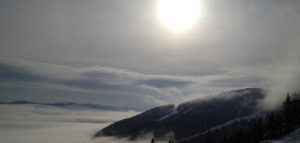The forgotten threat of nuclear winter
ø
For decades the threat of nuclear weapons use among major powers has declined. That decline stopped with the Russian invasion of Ukraine in 2022. As a consequence, experts broadly estimate that threat of nuclear war is at a 40 year high.
While we rightly focus on the perils of global warming, the use of only a portion of the world’s nuclear weapon anywhere in the world by any power could kill hundreds of millions of people outside the conflict zone in what scientists term ‘nuclear winter.’

In essence, nuclear winter results from explosions and subsequent fires associated with a nuclear exchange. Vast amounts of smoke, soot, and other particles, would be injected into the upper atmosphere and block sunlight from reaching the Earth’s surface for up to a decade. This would result in a significant global cooling and diminished sunlight that, in turn, will deadly to catastrophic crop failure and global famine.
The term was first used by Richard Turco, but the concept of nuclear winter was based on based on data and modeling done in the 1980s by Carl Sagan and others.
When a nuclear device explodes its fireball produces a thermally intense shockwave that essentially vaporizes everything within a distance from the base that varies by the strength and altitude of the explosion(s), topography, etc.
Incoming return updrafts following a nuclear explosion can be so intense that they push particulate matter up to 50 kilometers above the Earth’s surface, polluting the stratosphere and damaging its constituent ozone layer that protects the surface from harmful UV radiation.
Resulting firestorms caused by the incendiary shockwave can burn in cities and rural areas for months while they add to the atmospheric soot and debris levels. Driven by upper atmospheric jet streams, the particles in the stratosphere stream around Earth to dramatically block sunlight for up to a decade. The food ecosystem would collapse as crops fail and livestock die.
Without widespread International cooperation, deaths from famine and starvation would certainly follow. A study published in the journal Science in 2007 estimated that even if the US and Russia used only a small fraction of their nuclear warheads (e.g., 0.1 percent of their combined 1450 megaton arsenals, such a conflict could push teragrams of soot into the atmosphere. Modeling suggests that amount is sufficient to cool Earth by absorbing and scattering sunlight.I n 2019, a study published in the journal Proceedings of the National Academy of Sciences concluded, for example that a nuclear war between India and Pakistan, using 100 Hiroshima-sized bombs (and most US and Russian bombs now are far more powerful), could lead to a decline in global food production by 20 to 40 percent over the subsequent decade.
Alterations of surface temperatures could also alter precipitation patterns leading to increased wildfires and/or flooding.
The impacts of nuclear winter will vary by region. In 2019, a study published in the journal Earth’s Future asserted that higher latitudes would suffer cooling up to 20 degrees Celsius. Studies also suggest that nuclear winter could linger. In 2018, a study published in the journal Environmental Research Letters estimated that the effects of nuclear winter could last up to a decade.
Photo: Stowe, Vermont. Content and photo by K. Lee Lerner
- previous:
- Reading Caesar
- next:
- Scattershooting with Presidential couplets…


